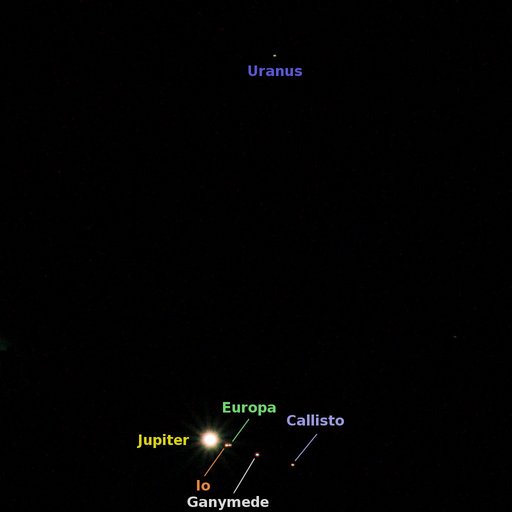« September 13, 2010 | Main | October 2, 2010 »
Monday, September 20, 2010
Jupiter and Uranus

Click image to enlarge.
Everybody should see each of the planets at least once in their lifetimes. If you haven't yet seen Uranus (please spare me the South Park giggles here), there's an excellent opportunity in the next few days since it's in the same binocular field of view as brilliant Jupiter, the brightest object (apart from the Moon) in the sky around midnight, high in the sky. Uranus is comparable in brightness to Jupiter's Galilean satellites, and is easily spotted with binoculars; in pristine dark skies and with excellent vision, it can be glimpsed with the unaided eye, but that isn't possible at the moment with the Moon shining so brightly. Still, it's easy with binoculars or the most modest of telescopes to find Jupiter, admire its moons, and then sweep toward the zenith (if you're in the northern hemisphere; toward the nadir if you're in the southern) and spot Uranus. Can you perceive its slight bluish tone? Compare its hue to Jupiter's moon Io, which is yellow by comparison. And then you've seen Uranus! Check that one off your list. The pinheads have already trimmed it by removing Pluto, but I'll bet it'll be back before long. Pluto requires a serious telescope, so complete the Grand Tour before they make it more difficult! The picture above was taken at 22:45 UTC on 2010-09-19 with a Nikon D300 digital camera with a NIKKOR 300 mm f/4.5 lens (equivalent with this camera's “DX” sensor to a 450 mm focal length on a 24×36 mm film camera) at f/8. This vintage lens has substantial chromatic aberration and coma at full aperture, so I opted to stop it down at the cost of increased sensor noise. I selected sensitivity of ISO 800 and an exposure time of one second; this resulted in a slight trail in this unguided exposure which is imperceptible in the reduced scale image above, but which can be seen in the full scale enlargement. The exposure was made in mirror lock-up mode with Nikon's electronic cable release.